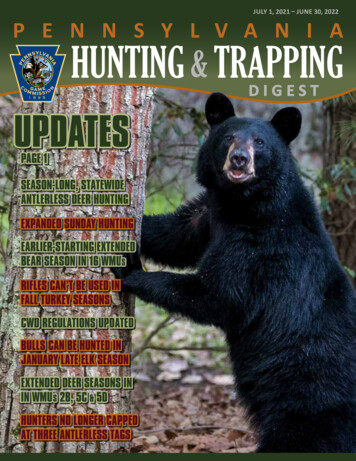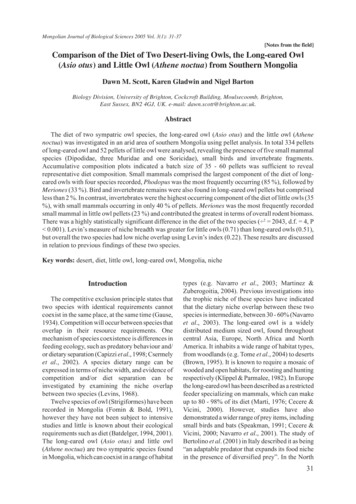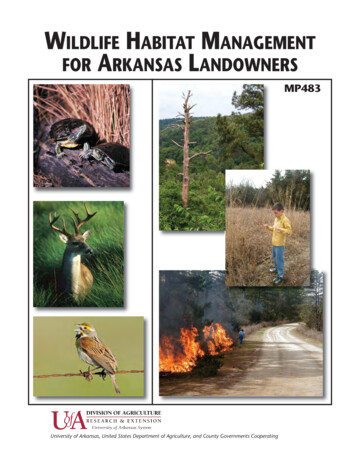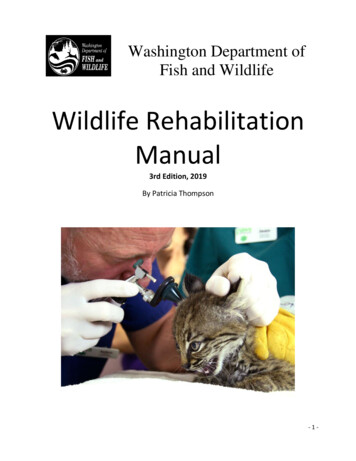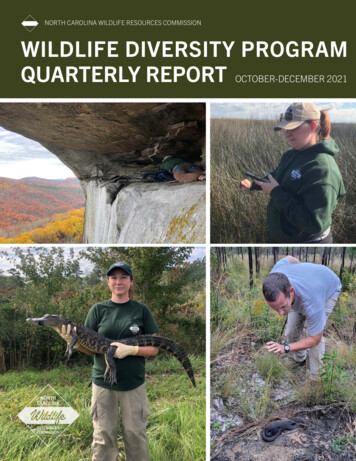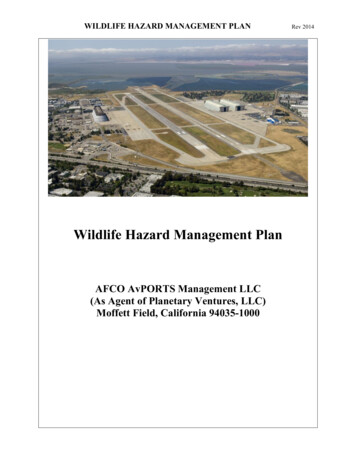
Transcription
8. OwlsOwls are birds of prey, occupying by night the huntingand feeding niches which the hawks hold by day. Superb,specialized predators, owls are adapted to find, catch andkill prey quickly and efficiently. They’ve been doing it forages; owl fossils found in the Midwestern United Statesin rocks of the Eocene period date back about 60 millionyears. Eight species of owls either nest or regularly visitPennsylvania in winter. Some species like the great hornedowl, barred owl, and Eastern screech-owl are permanentresidents. Barn owls, long-eared owls, short-eared owls,and northern saw-whet owls nest in the state but aremigratory. Some individuals apparently nest where theyspent the winter. Snowy owls are winter visitors, varyingeach year in the extent of their visitation to the state.Migrant owl populations seem to reflect the abundance ofprey populations, so they vary greatly from year to year.In general, the populations of owls are not well-knownbecause of their nocturnal habits. As such, these are amongPennsylvania’s most mysterious birds and deserve moreresearch and monitoring efforts.Taxonomists divide owls (order Strigiformes) into twofamilies, Tytonidae —barn owls—and Strigidae, a familyto which all other Pennsylvania owls belong. The barnowl ranges over most of the world, with related speciesin South America, Europe, Africa, Asia, New Zealand, andAustralia. Strigidae have near-worldwide distribution,including most Pacific islands and the arctic.The plumage of owls is dense and soft, making them lookheavier than they actually are. Their earth-toned feathercolors are broken into mottled patterns which blend intothe background of shaded daytime roosts and the darknessof night. The feathers on owls’ legs provide insulationand protect against bites by prey. Both sexes are coloredessentially alike, but females are usually larger and heavierthan males of the same species.Some unusual and highly effective adaptations help owlssurvive. Extremely large eyes and large retinas packed witha high number of light-gathering cells called rods maketheir vision 35 to 100 times more efficient than humansight at distinguishing small objects in low light. An owlcannot distinguish colors well, but it possesses binocularWildlife Note - 08Revised 02/2021Eastern screech-owlvision: each eye views the same scene from a slightlydifferent angle, thus improving depth perception. Eyes arefixed in the skull; to look to the side, an owl moves its head,and some species can twist their necks over 270 degrees—almost all the way around.An owl’s head is large and broad to accommodate twowidely spaced and highly developed ears. The facial discand facial ruff, which consists of paired layers of denselypacked feathers behind the ear openings, work togetherto funnel and intensify sounds. Owls hear sounds wellbelow the threshold of human hearing. Even in completedarkness, a barn owl can detect and catch prey by usingits hearing alone. Several owl species have asymmetricallypositioned ears for a greater ability to pinpoint prey. Thishighly developed sense of hearing allows some species todetect and capture unseen voles and mice under snow packor dense ground cover. The conspicuous “ears” or “horns”of great horned, long-eared and screech owls are reallytufts of feathers that have little effect on their hearing.More Wildlife Notes are available from the Pennsylvania Game Commission, Bureau of Informationand Education, 2001 Elmerton Ave., Harrisburg, PA 17110-9797. www.pgc.pa.gov
Owls are silent hunters that take their prey by stealth. Theleading parts of a night hunter’s wings—which cut the airwhen the bird flies—have soft, serrated edges. Turbulence andnoise is further reduced by soft fringes on the trailing edgeof primary and secondary feathers and a downy covering onprimaries, secondaries and wing coverts. These specializedfeathers, lightweight wings and a large wing surface area letan owl fly and glide nearly silently. As its flight is virtuallynoiseless, an owl easily hears other sounds while hunting. Itdescends to its target in a silent, mothlike glide.An owl grips and kills prey with its talons. Even the grip ofa small owl is amazingly strong. Two of these strong, sharpclaws branch off the front toes of the foot, and two off theback toes. If the prey is small enough, the owl swallows itwhole; otherwise it holds the kill with its talons, tears thecarcass apart with its hooked beak and bolts the pieces.The owl’s stomach absorbs nutritious portions and formsindigestible matter (hair, feathers, bones, claws, insect chitin)into round pellets that are regurgitated about seven hours later.Pellets, also called castings, can be found under daytimeroosts or nighttime feeding stations. Generally, the larger theowl, the larger its pellets. Pellets can be broken apart and thehard bony parts separated from the fur and feathers. Closeexamination of the hard items gives insight into the owl’s diet.These pellets are great educational tools for people, especiallychildren, to see first-hand what an owl eats. It is surprisingto many that most owls primarily eat small rodents and thesmaller owls eat a lot of insects.Most owls call to attract members of the opposite sex duringmating season and to announce individual territory. They alsocall softly for short-range communication between mates orbetween parents and offspring. When cornered or frightened,owls hiss or make clicking noises by snapping their mandibles(upper and lower parts of the bill).Owls do not build nests, preferring to take over abandonedcrow or hawk nests or use cavities in trees or holes in banks.They may add lining material to existing nests. Owls areearly nesters, some even lay eggs in late winter. By the timenestlings need fed and fledglings leave the nest, offspring ofother wildlife abound and are fairly easy prey for the adultsto provision the young or for the inexperienced young owls toprey upon.Owl eggs, usually three to five, are rounded, whiteand undecorated. Incubation is generally the female’sresponsibility, while the male hunts and brings food to thefemale. After the eggs hatch, both parents feed the young.Nestlings have thick white or light gray down. Young foundin the same nest are invariably of different sizes, becauseincubation starts as soon as the female lays the first egg(unlike many other birds, which begin incubating only after alleggs are laid), and therefore this egg hatches first. As much astwo weeks may pass between the laying and hatching of thefirst and last eggs. Young hatched latest will die if the parentscannot find enough food in the area, as the youngest nestlingscannot compete with the larger, older nestlings. This naturalcheck balances predator population with food supply andensures that surviving fledglings are strong.The sounds made by owls are among the most familiar nighttime natural sounds. The stereotype is that owls hoot, butseveral owls make no such sound and screech, whinny, orbark instead. Even the “hoot owls” have wide repertoires andmake many different kinds of sounds, especially in their moreintimate family relationships. They also make non-vocal noisesby snapping their bills when disturbed or clapping their wingsduring courtship flights.During the day, most owls stay in hollow trees or dark, densestands of vegetation, often the dense cover of conifer trees.They hunt mainly at night—occasionally at dusk or on cloudydays—quartering the ground in silent flight or scanning it froma convenient perch.Owls generally kill whatever is easiest to catch or find. As withmany natural predators, they are often blamed for killing moregame species and poultry than they actually kill. Owls arebeneficial birds of prey that help keep rodent populations incheck, including pest species that may be more active at night.Mice, rats and voles form a major part of the owls’ diets;smaller owls prey heavily on small animals, including mice,small birds, frogs and invertebrates, such as large insects,worms and crayfish. All Pennsylvania owls are federallyprotected under the Migratory Bird Treaty Act of 1918.Barn Owl (Tyto alba)The barn owl is a long-legged, light-colored bird with a white,heart-shaped face. It is sometimes called the monkey-facedowl. A barn owl is a medium-sized owl, 14 to 20 inches inlength with a 44-inch wingspan; females weigh about 24ounces, males up to 20 ounces. Both sexes have whitish orpale cinnamon underparts and buffy or rusty upper plumage.A barn owl has neither of two characteristics often associatedwith owls: “horns” or hooting-type calls. Its calls include along, drawn-out whistle, loud raspy hisses and snores.Barn owls nest in barns, church towers, hollow trees, cliffledges and rock crevices, old buildings, silos, ventilation shafts,and clay embankments. Although barn owls generally donot build a nest, the female may shred her own regurgitatedpellets to form a simple nest on which to lay her eggs. Theyusually nest in March, April or May and lay from 2 to 18eggs (generally four to seven) at two- to three-day intervals.Incubation takes about 33 days. Some pairs will initiate nestingin fall months. During nesting, barn owls may catch dozens ofmice and voles and store them at the nest site until the eggsbegin hatching.After the eggs hatch, both parents feed the young. Nestlingbarn owls can eat their weight in food every night. Youngleave the nest 7 to 10 weeks after hatching, after flightfeathers have developed.Barn owls hunt open fields, flying low over the ground insearch of prey. Ornithologists studied 200 disgorged pelletsfrom a pair of barn owls that nested in a tower of thePennsylvania Game Commission www.pgc.pa.govManaging and protecting wildlife and their habitats while promoting hunting and trapping for current and future generations.
barn owlSmithsonian Institution Building in Washington, D.C. Thepellets contained 444 skulls, including those of 225 meadowmice, 179 house mice, 20 rats and 20 shrews—all caught inthe city. Other studies have confirmed mice and shrews as thisowl’s main prey items. Small birds, insects, flying squirrels andrabbits occasionally are taken.The Pennsylvania Game Commission has been working withprivate landowners to protect barn owl nesting sites andstudy these charismatic birds. Recent studies have revealedthat Pennsylvania owls migrate to other states sometimeshundreds of miles away.Eastern Screech-Owl (Megascops asio)The screech-owl is the only small Pennsylvania owl with eartufts. It is under 10 inches long and males may be as smallas 6.5 inches long, with a 19-inch to 24-inch wingspan anda 5 to 7 ounce body weight. The species is dichromatic, i.e.exhibiting two color phases—gray and red—independentof age or sex, consistent from first plumage to old age andfrequently found in a single brood. Gray phase birds are adappled brownish-gray; red phase individuals are chestnutred, also dappled. The pale breast and belly are streakedwith dark gray or chestnut, depending on the color phase. InPennsylvania, the gray phase is more common than the redphase.and medium-sized birds like blue jays and northern flickers,crayfish, frogs and flying squirrels form the screech-owl’s diet;most non-insect food is taken during winter. Screech-owlshunt from a branch using a sit and wait strategy, pouncingon prey from above. It sometimes catches its meal on thewing and is capable of snatching aquatic prey, like tadpoles,from the surface of shallow water. Common in Pennsylvania,they live in a variety of wooded habitats where tree cavitiesare available, although it is less common, even rare, in large,contiguous blocks of mature forest. The Eastern screech-owlinhabits farm woodlots, orchards, wooded cemeteries andcity parks, stream edges and wooded residential areas oftowns and cities. Some screech-owls live in wooded backyardsespecially where there is a large birdhouse provided. BreedingBird Surveys have indicated a statewide population declineof 20 percent between the first Atlas of Breeding Birds inPennsylvania period (1983- 1989) and the second atlas period(2004-2009). West Nile Virus may have contributed to thesteep drop in screech-owl numbers in Pennsylvania since theaccidental introduction of the virus in 1999. This disease is asignificant mortality factor for this owl, and it remains to beseen how well the species develops resistance.Great Horned Owl (Bubo virginianus)This large owl is sometimes called the tiger of the air. It is anadept aerial predator with powerful talons capable of crushingthe spinal column of prey larger than itself. The great hornedowl weighs up to 3.5 pounds, is 19 to 24 inches in length andhas a wingspan range of 3 feet to nearly 5 feet. Females areslightly larger than males. A great horned owl has soft brownplumage above, mottled with grayish-white; undersides oflight gray barred with dark; a “collar” of white feathers onthe upper breast; a rust-colored face; and prominent eartufts, the so-called horns, up to 2 inches long. Great hornedowls are often mobbed by crows and other birds because oftheir predatory habits. The great horned owl is the night-timeequivalent of the red-tailed hawk (Buteo jamai).Screech-owls nest in unlined cavities of hollow trees, inabandoned holes of flickers and pileated woodpeckers andeven in larger birdhouses. In March or April, the femalelays four to five eggs; incubation takes about 30 days. Afterhatching, young remain in the nest for one month.The great horned is known as the “hoot owl” for its call,three to eight (usually five) deep, booming, uninflectedhoots: hoo-hoohoo hoo, given in a pattern somewhat likea Morse code message and has great carrying power. Thehoot of the larger female is higher pitched than that of themale due to her smaller syrinx. These owls hoot to stakeout territory and as part of the species’ mating activity. Thecourtship of great horned owls extends from fall into earlywinter, providing many nights of hooting serenades with pairsdueting in synchronized hooting sessions. In Pennsylvania,nesting females are on eggs in February and early March andoccasionally as early as late January. After fledging, the youngowls beg from their parents with a high-pitched call thatsounds somewhat like a barn owl’s call, but less raspy. Thesenight-time barking calls are sometimes given from prominentposts like tree tops and utility poles.The screech-owl’s diet is quite varied, perhaps the most variedof any North American owl, and includes many kinds of smallanimals. Large insects such as grasshoppers, katydids, mothsand beetles, mice, shrews, rats, squirrels, rabbits, small birdsGreat horned owls are believed to mate for life. They nest inabandoned squirrel, crow, heron or hawk nests, tree cavitiesor hollow stumps and are the earliest nesters of all owls.A mated pair cleans debris from an appropriated nest, andA screech-owl’s call is termed a “quavering whistle,” “mournfulwail” or “long, descending whinny with tremolo, repeated atirregular intervals” (huhuhuhuhu, etc.). This can be heard inspring and then again in late summer after the young leavethe nest.Wildlife Note - 08Revised 02/2021More Wildlife Notes are available from the Pennsylvania Game Commission, Bureau of Informationand Education, 2001 Elmerton Ave., Harrisburg, PA 17110-9797. www.pgc.pa.gov
great hornedowlSnowy Owl (Bubo scandiacus)Rare and irregular visitors to Pennsylvania, snowy owls showup mainly from November to January in response to foodavailability on the arctic tundra. Prey abundance, namely, alarge lemming population during the breeding season, allowssnowy owls to rear higher numbers of young in some years.Scientists believe that as this primary food source decreases,large numbers of snowy owls irrupt south in winter tosouthern Canada and northern United States seeking areaswith abundant prey. Population crashes of lemmings andhares, and the accompanying owl irruptive events, usuallyoccur at 4- or 5-year intervals. Immatures, which are darker incolor, go farther south than the adults.Plumage of the snowy owl is white barred with grayish-brown;its feet and legs are heavily feathered. Full, soft featheringkeeps the bird warm during periods of inactivity betweenwinter hunting forays.the female then partly lines a central hollow with feathers.She lays two or three eggs at several-day intervals, usually inFebruary, and may temporarily get covered with snow whileincubating.Great horned owls, especially incubating or brooding pairs,defend nests and young viciously and have even attackedhumans who got too close. Great horned owls are intolerantof other owls near their nests or inside their territories.Eggs hatch in about a month; nestlings are downy-white andhelpless. The young cannot fly until they are almost threemonths old and contour feathers have grown.The snowy owl is as large as the great horned owl, with a24-inch body length, 60-inch wingspan and body weight up to5 pounds (by weight, the largest owl in North America). It is abird of wide open, treeless, spaces which resemble its tundrahome. In Pennsylvania, it may be found on an elevated perchoverlooking open fields, airfields, reclaimed strip mines, theshorelines of open rivers and lakes or along broad highwaycorridors, and beaches. It often perches on a fencepost, raisedhill, hay bale, silo, grain elevator, or building to look for itsprimary prey of small mammals such as mice, voles, rabbitssnowy owlGreat horned owls prey on opossums, rabbits, rats, mice,voles, geese, herons, domestic poultry, grouse, squirrels, otherowls and hawks, foxes, skunks (this species’ defensive sprayapparently does not deter the great horned owl), domesticcats, weasels and muskrats. It is able to tear meat with itshooked beak. Generally, they are “perch and pounce” huntersthat sit in a tree or prominent post and attack prey fromabove. They occasionally scavenge on carcasses.The great horned owl is more commonly found acrossthe state than any other owl. This species has a verywide tolerance for climatic conditions, living in habitatsranging from boreal forests to dry grasslands and deserts.In Pennsylvania, it is found in a variety of habitats fromurban parks and cemeteries to large forest tracts. It prefersforest edges, open mature woods and agriculture land withwoodlots. The species ranges over most of North America,south into Central America and portions of South America.There has been a perceived drop in its population in recentyears as measured by Christmas Bird Counts and Breeding BirdAtlases. This owl is susceptible to West Nile Virus and mayhave suffered a set-back due to this disease.Pennsylvania Game Commission www.pgc.pa.govManaging and protecting wildlife and their habitats while promoting hunting and trapping for current and future generations.
and rats, but also will take birds and fish as opportunitypresents itself. Unlike most owls the snowy owl is diurnal,hunting throughout the long summer days on its Arcticbreeding grounds. In Pennsylvania, the snowy owl continuesthese habits and hunts during the day. It does not call south ofits arctic breeding grounds.long-eared owlBarred Owl (Strix varia)The barred owl is a large bird of the deep woods whichincludes forest swamps, riparian forests as well as uplandforest habitat. It has a rounded head, no horns and browneyes (it is the only brown-eyed Pennsylvania owl except thebarn owl; all others have yellow eyes). The barred owl rangesover the eastern United States but has expanded north andwest into the boreal forests of western Canada and south tonorthern California. The barred owl is closely associated withlarge unfragmented forest tracts, particularly mature forestswith large trees for nesting cavities. It prefers to nest in mixeddeciduous and conifer woodlands and is strongly associatedwith eastern hemlock. It often occurs in the same high-qualityand large-scale contiguous forests as the red-shouldered hawk(Buteo lineatus).A barred owl weighs up to 2 pounds, with a 44-inch wingspanand body length up to 20 inches. It has gray-brown plumagewith white spots on the back; whitish or grayish underpartsare barred with buff or deep brown, the barring crosswise onthe breast and lengthwise on the belly.The barred is the most vocal of Pennsylvania’s owls. Its hootsare more emphatic than those of the great horned owl,but not as deep or booming. The barred owl’s call is eightaccented hoots, in two groups of four hoots: hoohoo-hoohoo.hoo-hoo-hoohooaw (described as “Who cooks for you, whocooks for you all?”). It usually calls early in the night, at dawn,and occasionally on cloudy days.Barred owls almost always nest in hollow trees, layinganywhere from one to five eggs that hatch in 28 to 33 days.Pairs may show strong attachment to the same nest area,returning year after year. They are generally permanentresidents where they nest.barred owlLong-eared Owl (Asio otus)The long-eared is one of the most efficient mouse-catchersof the Pennsylvania owls. It is also one of the rarest breedingbirds in the state and listed as threatened in the state. TheState Wildlife Action Plan considers the long-eared owl a “HighLevel Concern” species and its population trends appear tobe declining as it was found in less than one percent of thetotal number of blocks surveyed during Breeding Bird Atlasprojects. This slender, crow-sized owl has long wings whichmake it appear larger in flight than it actually is; a long-earedowl has about a 15-inch body length, up to 40-inch wingspanand weighs about 11 ounces. This secretive and uncommonPennsylvania resident gets its name from two prominent eartufts.While it looks a bit like a small version of the great hornedowl, the long-eared can be told from its larger relative by astreaked belly—rather than barred—and closer-set ears. Thelong-eared owl is only about one-fifth the bulk of a greatWildlife Note - 08Revised 02/2021More Wildlife Notes are available from the Pennsylvania Game Commission, Bureau of Informationand Education, 2001 Elmerton Ave., Harrisburg, PA 17110-9797. www.pgc.pa.gov
horned owl. Conversely, the long-eared owl is much larger andhas a slimmer profile than the other “eared owl,” the easternscreech-owl. Like the great horned owl, the long-eared owlhas a rusty face and grayish-brown plumage. However, thelong-eared owl also has streaks continuing down its bellywhile the great horned owl lacks these streaks and the shorteared owl’s streaks are confined to the chest. The long-earedowl’s call is a low, moaning, dove-like hoo, hoo, hoo repeatedevery three seconds or so. They also have many other soundsincluding whistles, whines, shrieks, and bill snaps.Long-eared owls usually are associated with a curious blend ofhabitats. Paradoxically, they nest in wooded areas but usuallyforage in open country. Their home is a mix of woodland,fields, and wetlands. Long-eared owls generally nest in denseevergreen conifers, frequently in old crow or hawk nests. Theyforage in fields, meadows, open woods, wetlands, and edgesnearby. This also is true in winter when they roost in denseconifer tree groves, often communally. Females lay three toeight (normally four to five) eggs. Only the female incubates;incubation period is 26 to 28 days, and the oldest owlet maybe 8 to 10 days old when the last egg hatches.Long-eared owls feed mainly on mice, voles and shrews,occasionally taking birds, insects and frogs. They are morestrictly nocturnal than Pennsylvania’s other owls. Primehabitat is a mix of woodland, fields and wetland; densevegetation or dense groves of conifers for nesting and roostingadjacent to open woodland, fields, meadows or wetlands forforaging. They may also be found in extensive forests withareas of open understory and short ground cover for foraging.This species often will “freeze” in a cryptic pose right next to atree trunk to avoid detection. Long-eared owls are sensitive todisturbance at their nests and winter roosts. It is best to viewthese nesting owls at a distance so as not to disturb them.Short-eared Owl (Asio flammeus)Also called the marsh owl, the short-eared owl visitsPennsylvania mainly in winter and is a rare breeding birdthat is considered endangered in the state. It is a crow-sizeowl (body length 13 to 17 inches, weight 15 ounces) withlong wings (up to a 42-inch wingspan). Its upper plumage isstreaked and buff-brown, with large buffy areas on the upperwing surfaces; the breast is pale, boldly streaked with brown.The short-eared owl’s ear tufts are small and hard to see, butits ear openings are large and its hearing excellent.The short-eared hunts during the day and at night and isespecially active at dusk and dawn in winter. It hunts overopen country, and its irregular, flopping and floating flightresembles that of a nighthawk or large moth. The short-earedowl is a fairly silent owl but occasionally sounds an emphatic,sneezy bark, keaw, keaw, or a hooting call described as boo,boo, boo. Their courtship flight is a spectacular sky dance withthe male diving, looping, and swooping while calling in sight ofa prominently perched female.At winter’s end, most short-eared owls leave Pennsylvania andhead north. Pennsylvania is at the southern edge of the owl’sNorth American breeding range. Some remain in Pennsylvaniashort-eared owlto breed in extensive grassy areas scattered throughoutthe state. In recent years they have been found nesting onreclaimed strip mines in western and central Pennsylvania.Short-eared owls nest on the ground, sometimes in colonialgroups. The female excavates a slight bowl-shaped depressionin the earth or sand. The nest is sparsely lined with grasses,weed stalks and feathers. Bushes or clumps of weeds oftenhide the nest. The female typically lays four to seven eggs andincubates them about 21 days until they hatch.Small mammals, especially voles and mice, are the primaryprey of the short-eared owl. It also preys on shrews, rats andsmall birds. This owl may utilize an elevated perch whereavailable but mainly hunts by flying low over the ground,sometimes hovering, and then pouncing on its prey. Theyseem to take “the night shift” in the same areas wherenorthern harriers hunt during the daylight hours, sometimesskirmishing with these hawks or other owls. The short-earedowl depends mainly on its sense of hearing to locate prey andis able to catch its quarry unseen under snow cover and grass.This owl is found in open country and inhabits reclaimed stripmines, uncut grassy fields, large meadows, the grass marginsof airports, and marshes and bogs. They generally roost intrees, sometimes in large groups and occasionally with longeared owls.Northern Saw-whet Owl (Aegolius acadicus)The tiny saw-whet owl is one of the state’s most charismaticbirds. With a body length of 7 to 8 inches and an 18-inchwingspan, the saw-whet is the smallest Pennsylvania owl. Itsplumage is dull chocolate-brown above, spotted with white,and its undersides are white spotted with dark reddish-brown.Juveniles are a rich chocolate-brown over most of theirbodies. This species has no ear tufts.The saw-whet’s call is a mellow, whistled note repeatedmechanically, often between 100 and 130 times a minute: too,too, too, too, too, etc. This sound suggests the rasping madewhen sharpening a saw—hence the bird’s name. The sawwhet is nocturnal and seldom seen. By day, it roosts in young,dense hemlocks, junipers, or other dense vegetation.Saw-whet owls are believed to breed in March and April; theynest in natural cavities or deserted woodpecker and squirrelPennsylvania Game Commission www.pgc.pa.govManaging and protecting wildlife and their habitats while promoting hunting and trapping for current and future generations.
holes, hollow trees or stumps and nesting boxes. Femalestypically lay four to six eggs that hatch after 21 to 28 days.Immatures leave the nest after about a month. The sawwhet’s primary food is woodland mice, particularly deer miceand white-footed mice. Saw-whets also will feed on insects,voles, shrews, and small birds. In turn, they are preyed uponby larger owls like great horned owls and barred owls. Sawwhets tend to stay fairly low in the forest, approaching anyhuman visitor from a low elevation where they are difficult tospot in the dense foliage.northern saw-whet owlIn Pennsylvania, the northern saw-whet owl is found inhighland deciduous and mixed forests and is most abundantin coniferous forests and mixed forests with a thickunderstory such as those with blueberry, mountain laurel,and rhododendron stands. This species nests primarily inthe northern part of the state, but also in mountainousforests near the Mason-Dixon line. Winter roost sites areoften in dense stands of junipers (red cedars) or other tightlyvegetated evergreen conifers and vine tangles. Breedingseason surveys (called “toot routes”) have revealed that thesaw-whet is fairly widely distributed in the mountain forests ofthe state. There is on-going research on its migration into andthrough the state by bird banders (called “owl-netters”).Wildlife Note - 08Revised 02/2021More Wildlife Notes are available from the Pennsylvania Game Commission, Bureau of Informationand Education, 2001 Elmerton Ave., Harrisburg, PA 17110-9797. www.pgc.pa.gov
Owls are birds of prey, occupying by night the hunting and feeding niches which the hawks hold by day. Superb, specialized predators, owls are adapted to find, catch and kill prey quickly and efficiently. They’ve been doing it for ages; owl fossils found in the Midwestern United States in
